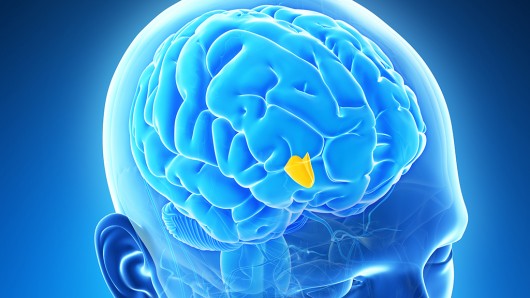
The small almond-sized portion of the brain known as the hypothalamus could be the body's 'Fountain of Youth' (Image; Shutterstock)
Instead of traipsing through Florida in search of the Fountain of Youth, Spanish explorer Juan Ponce de León might have been better off turning his search inwards. More specifically, he should have turned his attention to a region of the brain called the hypothalamus. At least that’s what research carried out on mice by scientists at New York’s Albert Einstein College of Medicine of Yeshiva University suggests. They found that the hypothalamus controls many aspects of aging, opening up the potential to slow down the aging process by altering signal pathways within that part of the brain.
Located just above the brain stem and found in all vertebrate brains, the hypothalamus is roughly the size of an almond in humans and is responsible for numerous functions, including growth, development, reproduction and certain metabolic processes.
Previous work by Dongsheng Cai, M.D., Ph.D., professor of molecular pharmacology at Einstein, and his colleagues had shown that inflammatory changes in the hypothalamus can lead to various components associated with metabolic syndrome, a combination of medical disorders that increase the risk of cardiovascular disease and diabetes.
This led Dr. Cai to suspect that the hypothalamus may also play a key role in aging, prompting him to study hypothalamic inflammation by focusing on a protein complex called NF-κB (nuclear factor kappa-light-chain-enhancer of activated B cells). This is a protein complex that plays an important role in regulating cellular responses, the production of small molecules used for cell signaling known as cytokines, and cell survival.
Dr. Cai and his team found that activating the NF-κB pathway in the hypothalamus of mice caused them to age faster by causing a decline in levels of gonadotropin-releasing hormone (GnRH). This hormone is synthesized in the hypothalamus and its release into the blood is usually associated with reproduction.
“The mice showed a decrease in muscle strength and size, in skin thickness, and in their ability to learn – all indicators of aging. Activating this pathway promoted systemic aging that shortened the lifespan,” he said.
Conversely, blocking the NF-κB pathway in the mice slowed the aging process and increased their median longevity by about 20 percent compared to the control group.
The researchers also found that injecting GnRH into a part of the hypothalamus known as a hypothalamic ventricle protected aged mice from age-associated impaired neurogenesis. In other words, the aged mice were better able to create new neurons. Mice that received daily GnRH injections for a prolonged period saw a slowing of age-related cognitive decline, which the researchers theorize is the result of neurogenesis.
Dr. Cai believes the findings offer two potential strategies for treating age-related diseases and increasing lifespan – preventing the hypothalamus from causing inflammation and using GnRH therapy to increase neurogenesis.
The technology has been made available for licensing and is detailed in a paper published in the journal Nature.
Source: Albert Einstein College of Medicine of Yeshiva University
Copyright © gizmag 2003 - 2013 To subscribe or visit go to: http://www.gizmag.com